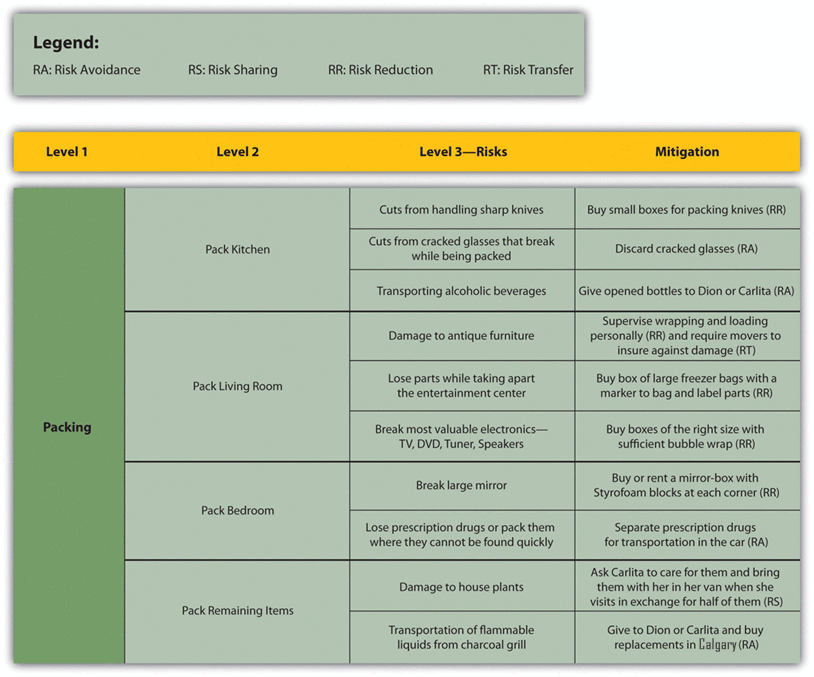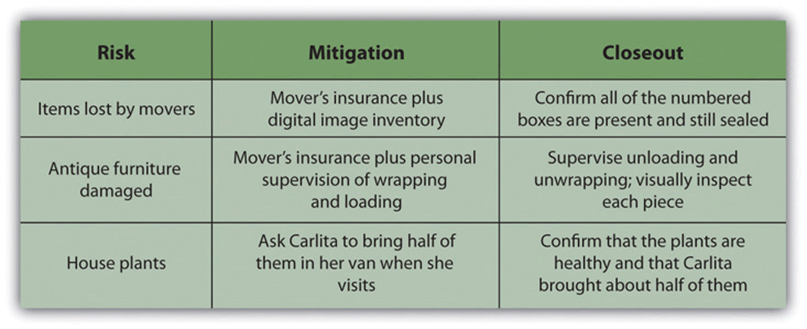11.3 Project Risk by Phases
Visit Audio Recordings for the audio version of this section.
LEARNING OBJECTIVES
- Describe the elements of risk management during the initiation phase.
- Describe the elements of risk management during the planning phase.
- Describe the elements of risk management during the execution phase.
- Describe the elements of risk management during the closeout phase.

Project risk is dealt with in different ways depending on the phase of the project.
INITIATION PHASE
Risk is associated with things that are unknown. More things are unknown at the beginning of a project, but risk must be considered in the initiation phase and weighed against the potential benefit of the project’s success in order to decide if the project should be chosen.
Risks by Phase in John’s Move
In the initiation phase of John’s move, John considers the risk of events that could affect the whole project. He identifies the following risks during the initiation phase that might have a high impact and rates the likelihood of their happening from low to high.
- His new employer might change his mind and take back the job offer after he’s given notice at his old job: Low.
- The current tenants of his apartment might not move out in time for him to move in by the first day of work at the new job: Medium.
- The movers might lose his furniture: Low.
- The movers might be more than a week late delivering his furniture: Medium.
- He might get in an accident driving from Vancouver to Saskatoon and miss starting his job: Low.
John considers how to mitigate each of the risks.
- During his job hunt, John had more than one offer, and he is confident that he could get another job, but he might lose deposit money on the apartment and the mover. He would also lose wages during the time it took to find the other job. To mitigate the risk of his new employer changing his mind, John makes sure that he keeps his relationships with his alternate employers cordial and writes to each of them thanking for their consideration in his recent interviews.
- John checks the market in Saskatoon to determine the weekly cost and availability of extended-stay motels.
- John checks the mover’s contract to confirm that they carry insurance against lost items, but they require the owner to provide a detailed list with value estimates and they limit the maximum total value. John decides to go through his apartment with his digital camera and take pictures of all of his possessions that will be shipped by truck and to keep the camera with him during the move so he has a visual record and won’t have to rely on his memory to make a list. He seals and numbers the boxes so he can tell if a box is missing.
- If the movers are late, John can use his research on extended-stay motels to calculate how much it would cost. He checks the moving company’s contract to see if they compensate the owner for late delivery, and he finds that they do not.
- John checks the estimated driving time from Vancouver to Saskatoon using an Internet mapping service and gets an estimate of 16.5 hours of driving time. He decides that it would be too risky to attempt to make the drive by himself in one day, especially if he didn’t leave until after the truck was packed. John plans to spend one night on the road in a motel to reduce the risk of an accident caused by driving while too tired.
John concludes that the high-impact risks can be mitigated and the costs from the mitigation would be acceptable in order to get a new job.
PLANNING PHASE
Once the project is approved and it moves into the planning stage, risks are identified with each major group of activities. A risk breakdown structure (RBS) can be used to identify increasing levels of detailed risk analysis.
Risk Breakdown Structure for John’s Move
Figure 11.3 Risk Breakdown Structure (RBS) for Packing John’s Apartment

EXECUTION PHASE
As the project progresses and more information becomes available to the project team, the total risk on the project typically reduces, as activities are performed without loss. The risk plan needs to be updated with new information and risks checked off that are related to activities that have been performed.
Understanding where the risks occur on the project is important information for managing the contingency budget and managing cash reserves. Most organizations develop a plan for financing the project from existing organizational resources, including financing the project through a variety of financial instruments. In most cases, there is a cost to the organization to keep these funds available to the project, including the contingency budget. As the risks decrease over the length of the project, if the contingency is not used, then the funds set aside by the organization can be used for other purposes.
To determine the amount of contingency that can be released, the project team will conduct another risk evaluation and determine the amount of risk remaining on the project. If the risk profile is lower, the project team may release contingency funds back to the parent organization. If additional risks are uncovered, a new mitigation plan is developed including the possible addition of contingency funds.
CLOSEOUT PHASE
During the closeout phase, agreements for risk sharing and risk transfer need to be concluded and the risk breakdown structure examined to be sure all the risk events have been avoided or mitigated. The final estimate of loss due to risk can be made and recorded as part of the project documentation. If a Monte Carlo simulation was done, the result can be compared to the predicted result.
Risk Closeout on John’s Move
Figure 11.4 Closeout of Risk Mitigation Plan for John’s Move

Risk is not allocated evenly over the life of the project. On projects with a high degree of new technology, the majority of the risks may be in the early phases of the project. On projects with a large equipment budget, the largest amount of risk may be during the procurement of the equipment. On global projects with a large amount of political risk, the highest portion of risk may be toward the end of the project.
KEY TAKEAWAYS
- During the initiation phase, risks are identified that could threaten the viability of the project. Mitigation options are considered to see if they would be sufficient to protect the project.
- During the planning phase, risks are identified and analyzed for each activity group in a risk breakdown structure, and mitigation is planned for each risk
- During the execution phase, risks are checked off as activities are completed or mitigation is performed if loss does occur. New risks are identified and added to the plan.
- During the closeout phase, insurance contracts are cancelled and partnerships terminated. A summary of actual costs associated with risks are compared with initial estimates to refine estimating capabilities. The successes and failures of the risk management plan are summarized and saved with the project documentation to add to the company’s corporate knowledge.
Identifying and assessing the risks to the project and managing those risks to minimize their impact.
Includes activities such as holding alignment and kickoff meetings, identifying the project team, developing the resources needed to develop the project plan, and identifying and acquiring the project management infrastructure. PMI calls this phase the “starting the project.”
includes developing detailed staffing, procurement, and project controls plans. PMI calls this phase “organizing and preparing.”
Includes the major activities needed to accomplish the work of the project. PMI calls this phase “carrying out the work.”
Includes transferring staff, archiving documents, closing offices, completing punch list tasks, and turning over the results of the project to the client. PMI calls this phase “closing of the project.”
the possibility of loss or injury.
A way of organizing identified risks into categories using a table format.
Prioritizing risks by the likelihood and potential impact.
Partnering with others to share responsibility for risk.
A risk reduction method that shifts the risk from the project to another party
A plan designed to eliminate or minimize the impact of risk events.
Development and deployment of a plan to avoid, transfer, share, and reduce project risk

